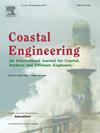用于热带气旋期间波浪建模的白浪消散过程研究
IF 4.2
2区 工程技术
Q1 ENGINEERING, CIVIL
引用次数: 0
摘要
大气-波浪相互作用是热带气旋期间的一个重要物理过程。对这一过程的了解和模拟对海岸和港口结构的技术和功能设计具有重要意义。在热带气旋的高风速下,被吹离海面的泡沫和喷雾在大气和海面之间形成滑动层。与低风速时相比,该滑动层使大气与波的相互作用表现出不同的特征。该滑动层对大气的重要影响是降低了空气动力表面粗糙度,从而改善了阻力系数的表达。在此基础上,本研究进一步探讨了滑动层对海面的影响。在高风速下,白帽覆盖率可能会达到一个较低的极限,根据白帽的经典现场观测结果,提出了一种改进的波谱模型白帽耗散数值方法。根据这些观测结果,当出现发展波时,白帽覆盖率的变化特征不同于低风速下的发展波。因此,应定义波浪状态的临界摩擦速度,由于波龄和波陡之间的负相关关系,该临界摩擦速度可以用发育波的阈值陡度来表示。然后修改消散模式,使其随着摩擦速度的增加逐渐达到临界值,这在用 26 个浮标测量的 24 个热带气旋中得到了验证。默认模式的负偏差一般随着摩擦速度的增加而减小,甚至达到-0.8 米,而修正模式的偏差大多维持在 0.2 米至-0.2 米之间。本文章由计算机程序翻译,如有差异,请以英文原文为准。
Study on whitecapping dissipation process for wave modelling during tropical cyclones
The atmosphere-wave interaction is an important physical process during tropical cyclones. Understanding and modelling of this process are of great significance for the technical and functional design of coastal and harbor structures. At the high wind velocities of tropical cyclones, foams and sprays that are blown away from the sea form a slip layer between the atmosphere and the sea surface. This slip layer makes the atmosphere-wave interaction exhibit different characteristics compared with that at low wind velocities. The significant effect of this layer on the atmosphere is the reduction of aero-dynamical surface roughness, which has been used to improve the expression of the drag coefficient. On this basis, the effect of the slip layer on the sea surface is further explored in this study. The whitecap coverage may reach a low limit at high wind velocities, and a modified numerical method of whitcapping dissipation for the wave spectrum model is proposed based on the classic field observations of whitecaps. According to these observations, when developing waves appear, the variation characteristics of whitecap coverage are different from those of developed waves with low wind velocities. Thus, the critical friction velocity of wave states should be defined, which can be expressed by the threshold steepness of developed waves due to the negative correlation between wave age and wave steepness. The dissipation mode is then modified to gradually reach the limit with the increase of friction velocities, which is validated during 24 tropical cyclones measured with 26 buoys. The negative Bias of the default mode generally decreases with the increase of friction velocity, even reaching −0.8 m, while the Bias of the modified mode is mostly maintained between 0.2 m and −0.2 m.
求助全文
通过发布文献求助,成功后即可免费获取论文全文。
去求助
来源期刊

Coastal Engineering
工程技术-工程:大洋
CiteScore
9.20
自引率
13.60%
发文量
0
审稿时长
3.5 months
期刊介绍:
Coastal Engineering is an international medium for coastal engineers and scientists. Combining practical applications with modern technological and scientific approaches, such as mathematical and numerical modelling, laboratory and field observations and experiments, it publishes fundamental studies as well as case studies on the following aspects of coastal, harbour and offshore engineering: waves, currents and sediment transport; coastal, estuarine and offshore morphology; technical and functional design of coastal and harbour structures; morphological and environmental impact of coastal, harbour and offshore structures.
 求助内容:
求助内容: 应助结果提醒方式:
应助结果提醒方式:


